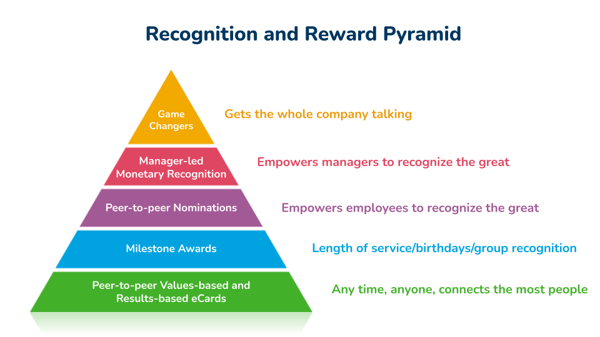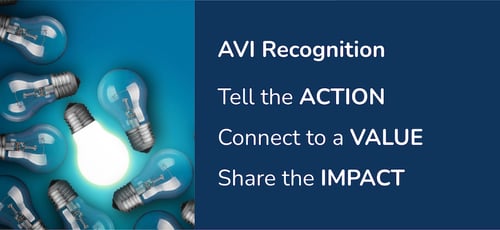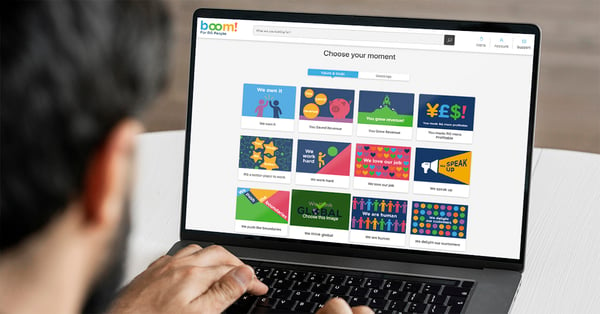Recognition itself is a powerful topic in 2022. Our recent survey found that 85% of employees say it's important employers enable recognition from peers and managers. Employees aren’t just hoping that their managers are good at recognition, they are expecting it as a part of their day-to-day working environment.
When we poll webinar attendees on which aspect of a recognition culture is a struggle, consistency always comes out at the top.
How can you knit together pockets of recognition into a company-wide plan in which employees are just as likely to get recognition, regardless of which department or location they work?
In working with clients around the world to ensure they’re getting the usage and cultural results they want through our technology, consistency is always a priority. Because of the focus on consistency, we’ve found five approaches that our clients have taken to build their own consistent recognition culture across their organization. Let’s take a peek at them:
- Make it easy to use. If it takes too much practice or time, people will rely on informal recognition and will only have access to the narrow band of recognition that happens near to them.
- Model with leaders. Manager recognition is among the most memorable. When managers aren’t involved, recognition efforts can feel less important and they become easy to abandon.
- Create community. Sharing and promoting recognition stories within and across groups builds connection and inspires employees to look for the great work around them.
- Make recognition meaningful. If we want people to get involved and stay involved the story and the topics that we focus on in recognition make a difference. Does it feel satisfying to be recognized, or am I silently rolling my eyes?
- Know your numbers. When it comes to measuring the success of recognition, metrics are essential. You can build on success. You will know when recognition is lagging and can address it.
Amplifying recognition usage through easy access
 Our clients are most successful when they put recognition where employees already are. It might be an integration with MS teams or Slack, or something simple like having the program automatically load when they open a browser on their computer.
Our clients are most successful when they put recognition where employees already are. It might be an integration with MS teams or Slack, or something simple like having the program automatically load when they open a browser on their computer.
That last tip recently led to a client having 87% of employees having logged in within days of their program launching.
While it is easy for us as administrators to have everything online, if you have populations that still struggle to be online – even with an app – our clients get creative about making recognition happen in-person.
You could start by kicking off meetings with recognition stories, having paper forms that can be entered online, or even rewards that can be handed out on postcards and then redeemed online.
You can even make showing appreciation easy and simple for your program administrators. Setting up automatic milestone recognition means that without anyone needing to remember, employees get a card on their birthday and anniversary. That means that everyone consistently gets a message on their actual milestone – rather than when certain managers remember – and also means they have a guaranteed reason to log in and see that message.

Getting leaders involved with a consistent recognition culture
Opening regular meetings with a moment for recognition stories allows managers – with no preparation time needed – to demonstrate the value of recognition. I suggest taking this a step further and introducing this simple introduction during executive or leadership meetings, and that will help those leaders keep the practice going in their smaller meetings as well.
It’s hard to argue you don’t have time to recognize when your CEO takes time at the start of their meetings for the practice!
With online recognition, we sometimes hear from leaders that they aren’t in the trenches with employees to see great work so they struggle to find relatable stories to post. All the more reason for managers to be out commenting and reacting to online recognition stories. This practice is reactive and easy to fit into your day and if a department leader isn’t as consistently active with recognition, it more than makes up for that when your CEO chimes in to acknowledge your great work.
Creating community in the workplace for greater connections through recognition
 While we may technically connect with people as part of meetings and emails, recognition is a more human form of connection that takes connection to a deeper level. It is important to make space for this in our meetings and conversations.
While we may technically connect with people as part of meetings and emails, recognition is a more human form of connection that takes connection to a deeper level. It is important to make space for this in our meetings and conversations.
Consistency of recognition is also driven when people are encouraged to share recognition across groups. When people have the ability to reach between groups to recognize or tell recognition stories, it supports those groups with a weaker recognition culture. Here are a couple of examples:
| Perhaps you have a fast-paced facilities team that is focused on a growing list of problems to address – giving others the means to thank them for their efforts will ensure they credit for their fast pace. |
| Opening up recognition channels can also inspire and teach employees across the business. I’ve heard of nursing teams that were struggling to work with their Emergency Department because of incomplete information or slow responses. By intentionally sharing stories of the great work from the ED, it helped groups gain empathy for the team and understand how best to work together and support one another to deliver an amazing patient experience. |
| I was talking with a Director of IT about why they used online recognition. He shared that - while he was consistent at recognizing the team during internal meetings - the online recognition was more about sharing the talent and skill of his team with other groups. When those groups understand the important actions his team takes on a daily basis to contribute to the business, they are more likely to approach his team with respect and collaboration. |
How can recognition be more meaningful?
When it comes to keeping recognition meaningful, one element is variety. If recognition is always delivered in the same form even something thoughtful like a handwritten card can have a reduced impact.
Our clients like to have layers of recognition with varied levels of frequency and impact to keep things fresh.
For this, we like to look at our Recognition Pyramid for a framework to follow. As the pyramid widens, the more this form of recognition will touch (for instance, peer-to-peer recognition, for everyone) versus the narrower top of the pyramid which may be those next-level monetary awards for your gamechanging employees.

Another strategy for making sure recognition is meaningful and thus used consistently is to suggest important actions as topics for recognition. We often find that if you ask, “Who deserves recognition?” you may get less enthusiastic responses than if you ask, “Who always has positive energy?” or “Who is consistent at picking up extra shifts?” Along with more all encompassing values-based recognition eCards, our clients often call out these specific actions so employees and leaders can celebrate them.
Finally, how you tell the recognition can make it more or less meaningful. Simply saying, “Thanks for your help in the meeting!” shares the specific thing the person did – but it also is just repeating back to them something they already know. One way to kick recognition up a notch is to highlight how their actions impact others or support a higher purpose, such as, “The questions you asked at the end of the meeting demonstrated our value of Curiosity, ensured we didn’t miss anything, and will save us time in the long run.” Sharing the impact is more likely to break through the noise of a busy day and actually make someone feel appreciated. We call this AVI recognition – a story that highlights the Actions of the person, the Value they supported and the Impact they had.

Understanding the numbers (and the power!) behind consistent recognition
Finally I love looking at reporting with our clients to identify positive trends to celebrate and build on and to identify ways to improve the quality of recognition overall. Having this knowledge allows you to target the most valuable messages to drive success rather than just sending a “use recognition better” announcement and expecting results.
For example, if you know that 40% of people are sending recognitions, you can share that fact and encourage more people to be proactive. If you know that Happy Birthday is the most commonly sent eCard, you can thank people for honoring milestones, but encourage them to also send value-based eCards so people are more likely to get recognized once a month vs. once a year.

What’s more, data that points out your recognition rock stars allows you to personally thank them so they keep up the good work, or even highlight them to others as models. Do you have a manager that sends recognition consistently each week? Have them promote the program in a newsletter or meeting so other managers can see that level of consistency as possible.
While each company is different – we hope these five strategies for making recognition consistent will help you make the most of your program and make it more likely that all groups at your company can benefit from recognition.

%20(1).jpeg) Alexandra Powell
Alexandra Powell

